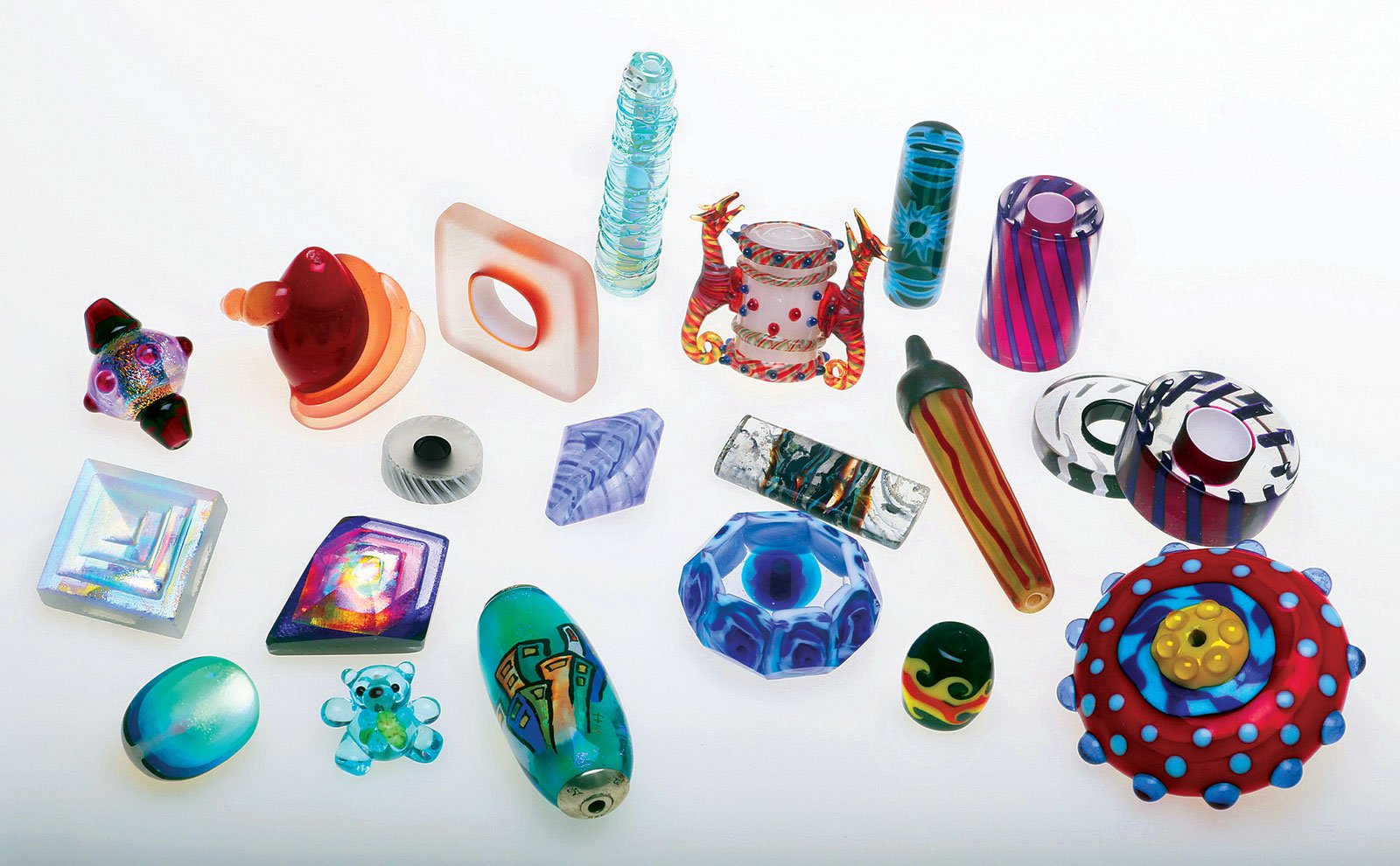Creativity in Glass 44.2
ARRAY OF DAZZLING ISLAMIC GLASS BEADS FROM IRAN, and possibly other countries, showing a profusion of styles, colors, shapes, and sizes, from the Dr. Hamid Reza Zohoorian Collection. While some of their glass compositions have been analyzed, and it is likely they were furnace made, how these medieval glass craftspeople were able to achieve such shapes, patterns, techniques, and sizes is not really known, except by inference to extant ethnographic glass beadmakers still using furnaces, and by referring to European studies on medieval beadmaking, like Sode (2003, 2004, 2010). Photograph by Dr. Hamid Reza Zohoorian.
Since writing about glass beads of the Islamic Period, especially those which might have been made between the 7th and 12th centuries A.D. by men, I have been struck by their skill and exuberance (Liu 2012). In the late 20th and early 21st centuries, we witnessed another outburst of glass bead creativity around the world, by glass workers of both sexes. Based upon loans from Thomas Stricker, images from the Zohoorian Collection and the contemporary, glass artist-made beads in the Ornament Study Collection (earliest 1965, most 1987-2017), I thought it would be instructive to visually compare glass beads made about 800-1400 years ago, with contemporary ones collected during the recent peak of glass beadmaking, often covered by Ornament, starting 43 years ago, resulting in one hundred and nine articles on contemporary and ethnographic glass beadmakers, conferences and shows where such beads are shown or sold. Over fifty glass artists worldwide have been profiled, some more than once, not counting those in group shows or events.
Islamic glass beads originated in the Middle East and flourished mostly between the seventh and twelfth centuries. Their designs display a wide range of techniques, sizes and styles: millefiori/mosaic (including pierced mosaic pad beads), trailed, filigreed, combed, fused rods, segmented/blown, and folded/mirror beads (if not an Islamic innovation, certainly used expansively by their beadmakers). Most likely made in a clay furnace, using wood/charcoal as fuel, with simple tools (Heaser 2021, Risom 2013, Sode 2004), often using recycled glass, but with a great deal of skill, they are very different from recent beads. Contemporary beadmaking is often meant as a stand alone piece of art, a collector’s item or a focal point of a necklace. A few modern beadmakers use furnaces or kilns, but most employ torches capable of great flame control as to size and intensity of heat, with custom-made marvers and other glass tools, utilizing glasses with controlled composition, or unusual characteristics such as borosilicate, Wasser or dichroic. Although some contemporary glass beadmakers were aware of historic glass beads, most sought to distinguish themselves in the crowded field by new forms or techniques. Sizes increased markedly, so that the small and tiny beads of the Islamic Period were no longer made. The transparency of glass was widely utilized, compared to its rarity with medieval beadmakers, who often worked under difficult conditions, as warfare raged upon the Islamic states from the Mongols (Francis 2002).
Click for Captions
REFERENCES/BIBLIOGRAPHY
Andersen, J. H. and T. Sode 2010 The Glass Bead Material. In: M. Bencard & H. B. Madsen (eds): Ribe Excavations 1970 - 1976, 6: Jutland Archaeological Society Publications.
Francis, P. 2002 Asia’s Maritime Bead Trade. 300 B.C. to the Present. Honolulu, University of Hawai’i Press: 305 p.
Giberson, D. 1996. Ancient Glassmaking. Its Efficiency and Economy. Ornament 19(4): 76-79.
Heaser, S. 2021 Early Anglo-Saxon Beadmaking in Britain. Reconstructing the Past Through Glass. Ornament 42 (1): 28-33.
Liu, R.K. 1994 Conference. Bead Expo ‘94. Ornament 17(4): 120-121.
—1998 Zephyr Glass. Furnace-worked Ornaments. Ornament 22(2): 54-57.
—2001 Glass arts. Bruce St. John Maher. Ornament 25(2): 10-11.
—2004/2005 Molly Haskins. Cut and Paste Kiln-formed Glass Beads. Ornament 28(2): 58-61.
—2012 Islamic Glass Beads. The Well-traveled Ornament. Ornament 36(1): 58-63, 70.
—2014 Collectibles. Art Seymour. Chevron Bead Maestro. Ornament 37(5): 68-71.
Risom, T. 2013 Perlemageren fra Ribe: Historien, Materialerne og Teknikkerne, Sydvestjyske Museer, Forlaget Liljerget.
Ross, A. 1994 Master Class with Molly V. Haskins. Kiln-formed Glass Beadmaking. Ornament 18(1).
Sode, T. 2003 Viking Age glass beads from Ribe, Denmark, in the light of ethnographic research. In: Glover, I.C. et al., (eds.) Ornaments from the past: Bead studies after Beck. London, The Bead Study Trust: 47-58.
—2004 Glass Bead Making Technology. In: M. Bencard, A. K. Rasmussen & H. B. Madsen (eds): Ribe Excavations 1970 - 1976, 5: Jutland Archaeological Society Publications: 83-102.
—2010 An investigation on segmented, metal-foiled glass beads and blown, mirrored glass beads from Ribe, Denmark. In: C. Dobiat, P. Ettel und F. Fless, Zwischen Fjorden und Steppe. Festschrift für Johan Callmer Zum 65. Geburtstag. Internationale Archäologie Studia honoraria 31: 219-328.
Ukai, N. 1980 Kyoyu Asao, Tombodama/Glass Bead Master. Ornament 4(3): 13-18.
Click for Captions
Zephyr lustre drapery beads, made 1996-1998 by John Curtis and staff, 3.3-5.6 centimeters wide or high, furnace-made and among the most beautiful of contemporary glass beads (Liu 1998). Several are borosilicate, one uses dichroic glass; Giberson bead made with hollow core and frit (Giberson 1996). Seymour snake chevron made from selected Chinese chevron beads (Liu 2014). Except for the O’Grady borosilicate mosaic bead, there is almost no overlap in techniques with Islamic Period beads.
Robert K. Liu is Coeditor of Ornament, for many years its in-house photographer, as well as a jeweler using alternative materials like heatbent black bamboo and polyester fibers. His last book, The Photography of Personal Adornment, covers forty-plus years of shooting jewelry, clothing and events related to wearable art, both in and out of the Ornament studio. Jewelry of Chinese faience, composites and glass, ancient, ethnographic and contemporary, are among some of his research interests, as well as Roman mosaic face beads. In this issue, he writes about the wide range of stone beads and pendants used in prehispanic Americas. In addition, he visually compares the skills of medieval glass beadmakers versus the outburst of glass beadmaking in the 20th and 21st centuries around the world. p. 24, 56














